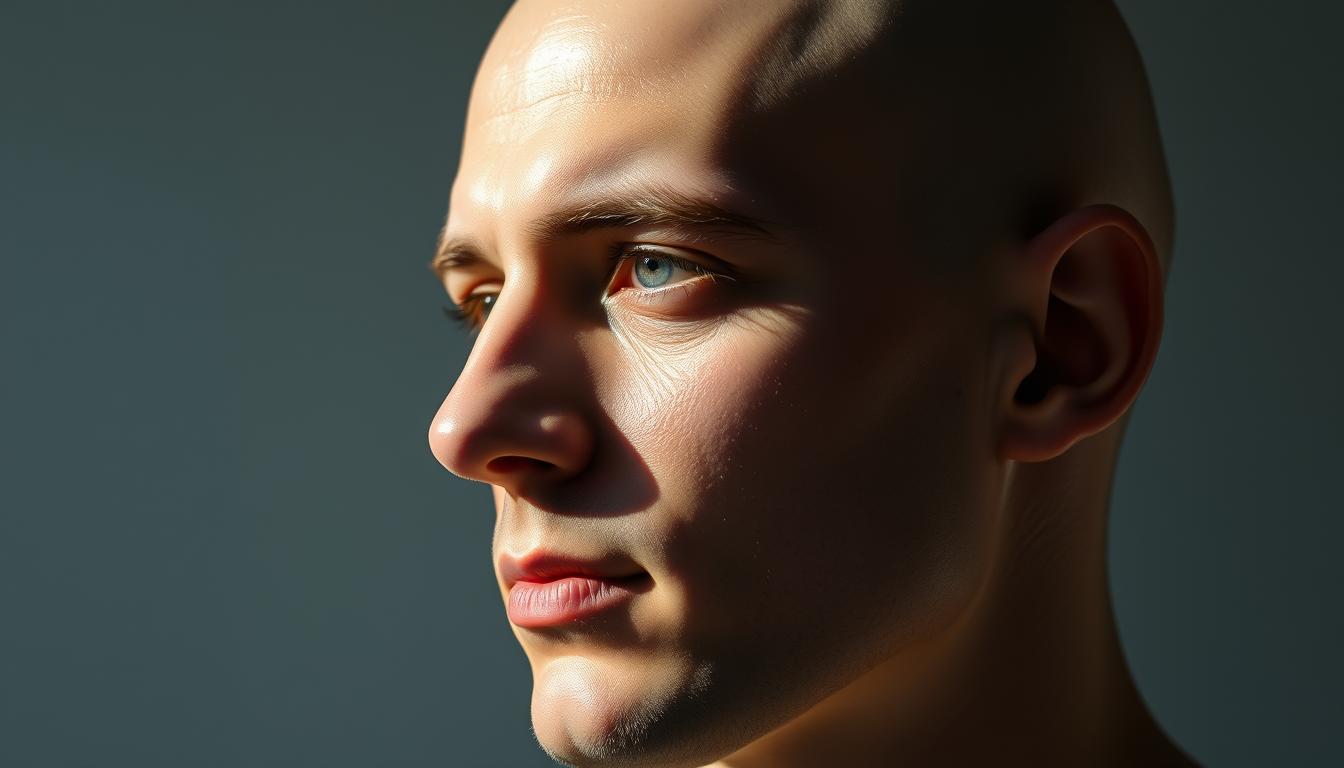
Choosing a shaved look can be a bold, deliberate move. Many men pick it for a sharp, low-maintenance aesthetic that boosts day-to-day confidence. A clean shave or short buzz removes the stress of hiding thinning areas at the top and hairline.
This style often flatters athletic builds and square or oval faces. It also pairs well with a fuller beard, which adds jawline definition when the head is bare.
We’ll walk through options from clean-shaven to short buzzes and transition cuts. You’ll get practical tips on shaving technique, scalp care, and SPF to keep skin smooth and irritation-free.
Expect a friendly, practical guide: who this look suits, which cuts to try or skip, how to handle sensitive spots, and evidence-based notes on causes of hair loss and treatments if you want to preserve what remains.
Key Takeaways
- Shaving or a short buzz offers a confident, low-maintenance look for many men.
- Head shape and facial structure matter; a beard can balance proportions.
- Simple routines—shaving technique, scalp care, SPF—keep the style neat and healthy.
- We cover early-stage options, cuts to avoid, and safe shaving tips for sensitive spots.
- Information on thinning causes and treatments helps you choose whether to preserve or embrace the look.
Understanding the bald haircut trend in the present day
The close-shaved look has become a go-to response when men notice thinning at the crown. It removes the daily task of hiding spots on the top and gives a clean, modern presentation.
Many men report that visible hair loss affects confidence at work and socially. Embracing a shaved head can feel liberating and practical after years of patchy coverage.
Media and public figures have helped normalize the style. From actors to entrepreneurs, stubbled and trimmed heads are now seen as deliberate, confident choices rather than signs of defeat.
- Why it’s surged: simple upkeep and no hiding thin spots.
- Who picks it: men with crown or mid-scalp thinning where blending fails.
- Practical perks: consistent photos, fewer bad-hair days, and easy seasonal styling with hats and SPF.
Short options like stubble or a buzz remain popular across ages and face types. In the next section, we’ll cover who suits this look based on head shape, lifestyle, and comfort level.
Who a bald haircut suits best: face shapes, lifestyle, and confidence

A close-shaved head can sharpen facial angles and simplify your daily routine. It works especially well for people with square or oval heads because the geometry of their faces pairs naturally with a short silhouette. Angles and symmetry stand out when hair is cut very short.
Square, oval, and round heads: what flatters your features
Square and oval faces suit a near-shaven top because the shape keeps proportions balanced. If your hairline is receding or a crown shows thinning, going shorter reduces contrast between sparse and dense areas. That makes the top look neater and less patchy.
For round heads, add structure with facial hair. A short boxed beard or defined stubble gives the illusion of a longer face and a stronger jawline. Keep sideburns aligned and the neckline tidy to maintain clean lines.
Active lifestyles, low-maintenance routines, and professional settings
Active men love this approach for its sweat-friendly, helmet-ready practicality. You save time—no blow-drying and fewer products—so mornings become easier. In professional settings, a consistent, well-kept scalp pairs cleanly with suits and casual wear.
Try a short buzz first if you’re unsure; it previews the silhouette without a full shave. Also, eyebrow grooming and beard shaping become more visible, so small tweaks can boost overall confidence and style.
Bald haircut inspiration: clean shave, stubble, and buzzed options
Start by deciding how bold you want the transition to be. A few small choices—length at the top, edge crispness, and whether to keep facial hair—shape the final look.
Clean-shaven head for a bold, timeless look
The clean shave is the most decisive, low-contrast option. It removes the need to disguise hair loss and reads as neat in both casual and formal settings.
Maintenance is frequent: daily or every-other-day shaving keeps the finish ultra-smooth. Use a quality rotary shaver and a post-shave moisturizer to avoid dryness.
The Statham-style head stubble for a rugged vibe
Head stubble is a softer alternative if a full shave feels extreme. Trim every few days to hint at hair without highlighting thin areas.
This Jason Statham–inspired look pairs well with light facial hair and suits mature men who want presence with low upkeep.
Buzz cut variants for thinning or balding tops
Buzz cuts are versatile: go uniform, keep a bit more length on the top with tighter sides, or choose a high-and-tight for crisp edges.
Buzzing softens the boundary between a thinning top and denser sides, reducing visual patchiness. Try different guard lengths to find the sweet spot, and consider a short boxed beard to sharpen the jawline.
- Maintenance cadence: daily shave for smooth, weekly for stubble, biweekly for buzz upkeep.
- Use a good clipper or a rotary head shaver to cut down nick risk.
- Always moisturize after shaving or buzzing to keep the finish even.
Classic short cuts that transition well to a bald haircut
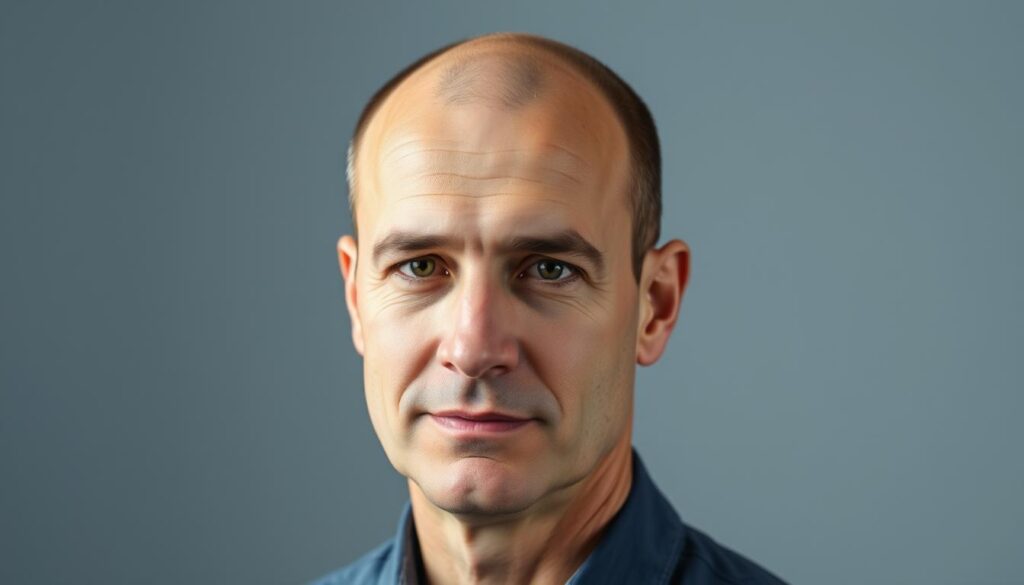
Classic short cuts can ease the shift from fuller hair to a near-shaved look while keeping a tidy profile.
Crew cut with slightly longer top for subtle coverage
The crew keeps the sides and back shorter with a touch more length on the top to add modest coverage.
Try a messy, textured finish to break up shine and diffuse light. Texture disguises minor crown thinning and reads natural in photos.
Tapering the sides and back gives a clean, professional outline. Quick clipper touch-ups every 3–4 weeks keep the shape crisp.
Caesar cut to minimize crown and hairline contrast
The Caesar’s short, choppy fringe reduces contrast at the front and helps mask a receding hairline.
Pair this style with a short, tidy beard to draw attention to your face and eyes rather than sparse areas.
Use a light matte product for texture without sheen. Both cuts transition easily into a buzz or full shave if loss advances.
- Ask a barber about the right top length as density changes.
- Keep the neckline crisp to avoid a fuzzy outline as it grows out.
- If frontal density is very low, move to a shorter buzz for a cleaner result.
Early-stage options before going fully bald
Early changes at the front or crown don’t mean you must go short—smart styling can keep a polished look for months.
Slicked back and combed-back styles work best when the hairline still has solid density. A medium top length lets you sweep strands back to soften a small crown spot.
Use a light mousse or gel to hold hair in place without clumping. Matte pastes and light spray keep volume and avoid heavy shine that exposes the scalp.
Slicked-back and comb-back when the front is still strong
These styles read intentional if the front remains full. Keep the sides and back tidy with a high fade or taper to modernize the look.
Business cut for neat, mature styling
The business cut pairs a clean side part with neat sides and back and a touch of top volume for office-friendly polish. It suits square and oval faces when mid-scalp density holds up.
“If mid-scalp thins, shorten the top or move to a buzz to avoid a comb-over effect.”
- Trim regularly to prevent wispy ends that highlight loss.
- Test styles now so transition to shorter cuts feels natural later.
- Avoid pulling hair too tightly to reduce traction stress.
Styles to skip when hair loss advances
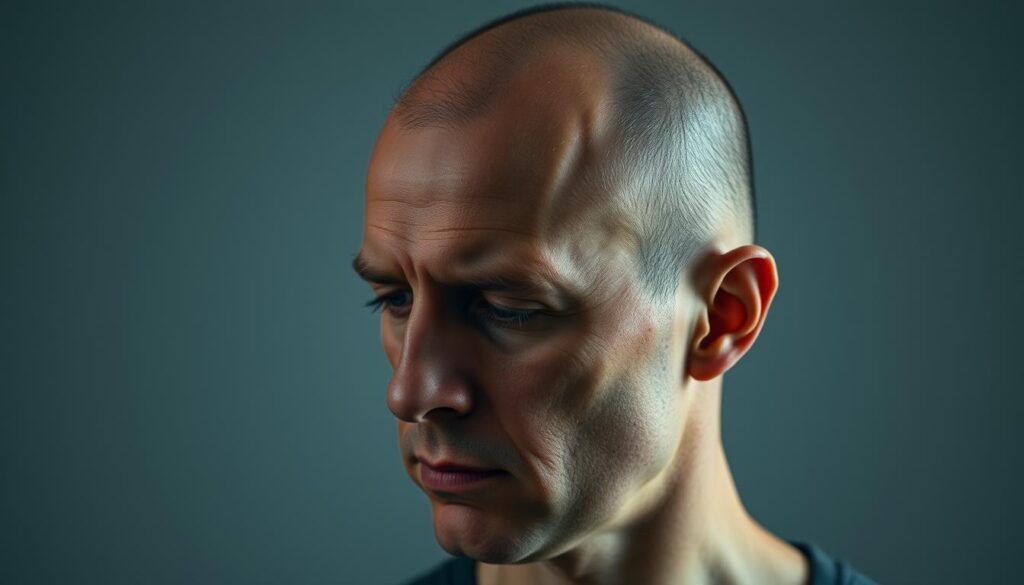
As density drops, certain looks begin to highlight gaps instead of hiding them. Avoid see-through combovers: they rarely cover a bare spot well and look obvious in wind or motion. That draws attention to the very area you want to downplay.
Power donut refers to a ring of puffed hair circling a bald crown. It often reads older and creates a heavy silhouette. A minimal buzz or clean shave usually offers a neater, more modern way forward.
Be careful with tight braids, cornrows, or locs. When density is low, these can cause traction alopecia and speed up loss. If you love longer styles, keep them loose and avoid high-tension patterns.
Long hair paired with a bare crown creates high contrast and confuses the eye. Sparse spiky looks do the same: thin spikes spotlight gaps. Embrace shorter lengths to reduce contrast between the top and the sides.
If you’re unsure, get a pro opinion and try a weekend trial buzz to see how shorter lengths photograph and feel. Hats and bandanas help situationally, but they are not a universal solution for work or formal settings.
| Problematic Style | Why to Avoid | Better Way |
|---|---|---|
| See-through combover | Moves in wind; looks like a cover-up | Short buzz or clean shave |
| Power donut | Creates aged, heavy ring around crown | Minimal buzz for clean silhouette |
| Tight braids/locs | Can cause traction alopecia when density is low | Loose styles or shorter cuts |
| Long top with bare crown | High contrast that confuses the eye | Trim shorter or shave |
| Sparse spikes | Accentuates gaps between strands | Even short length to reduce focus on gaps |
Remember: choosing the right way forward is about clarity and confidence, not hiding. A simpler silhouette often reads stronger and more intentional for men facing balding or hair loss.
Pairing a bald haircut with facial hair for balance
Adding a well-kept beard redirects focus from the top and gives the face more structure. Rugged facial hair pairs naturally with a shaved or buzzed head and restores visual weight. Many men see fuller beard growth even as scalp loss progresses because of hormonal patterns.
Short boxed beards vs. full beards: enhancing jawlines
Short boxed beards create a squared, controlled line. They sharpen the jaw and suit rounder faces by adding definition.
Full beards add bulk to the lower face and work well for men who want a stronger contrast next to a smooth scalp. Keep a weekly or biweekly trim to avoid an untidy look.
Stubble maintenance to complement a shaved scalp
Designer stubble is the lowest-maintenance option. Trim every 2–3 days for consistent texture that doesn’t overwhelm finer features.
Align cheek and neckline edges for a crisp finish. Use a light beard balm or oil to soften hair and reduce itch, especially when the head is closely trimmed for contrast.
- Trimming cadence: stubble 2–3 days, boxed beards weekly shaping, full beards biweekly lineups.
- Density tip: if growth is patchy, keep length short and even for neater appearance.
- Mustache options: try a chevron or minimalist style to tweak proportions without adding bulk.
| Beard Type | Best For | Maintenance |
|---|---|---|
| Designer stubble | Low effort; adds texture | Trim every 2–3 days; light oil |
| Short boxed beard | Sharp jawline; round faces | Weekly shaping; define cheek lines |
| Full beard | Strong contrast; adds weight | Biweekly trims; balm or oil |
Remember: facial hair can restore visual balance and boost confidence. Experiment with length, mustache shape, and line placement to find the style that suits your face and lifestyle.
At-home shaving routine: a step-by-step guide
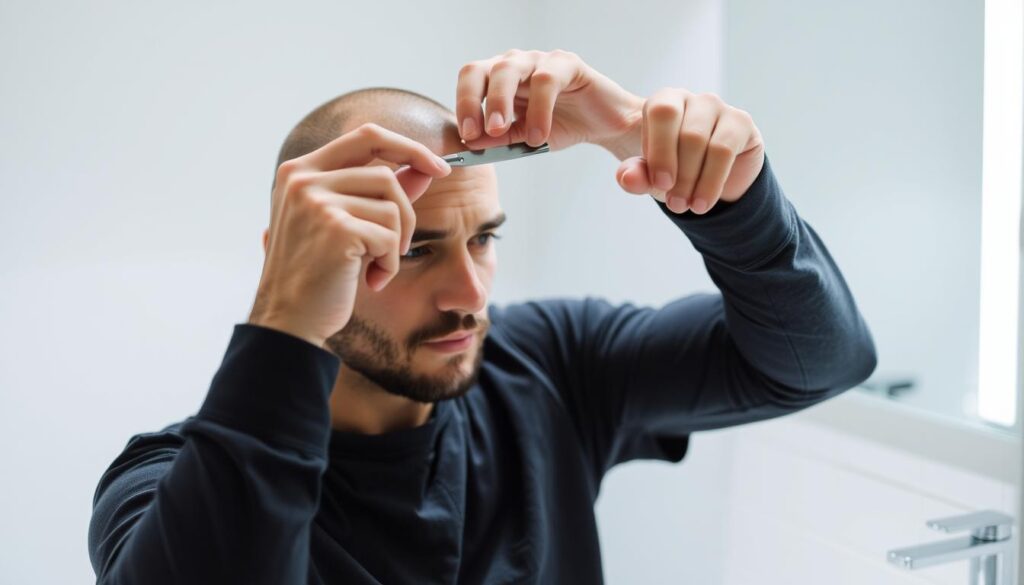
A reliable at-home shave starts with simple prep and the right tools to avoid nicks. Warm water opens pores and softens stubble, making each pass smoother. Read through the steps before you begin.
Prep, tools, and direction for fewer nicks
Prep matters: take a warm shower, exfoliate gently, and apply a slick shave gel to lift stubble and reduce friction.
- Use a dedicated head shaver or a flexible cartridge razor that follows the scalp contour.
- Shave with the grain first to minimize cuts; do a light cross-grain pass only if needed.
- Keep pressure feather-light, especially on the horseshoe area; a rotary head shaver works well for that zone.
- Stretch skin gently with the free hand to flatten ridges for a safer pass.
- Rinse the blade often and replace cartridges to avoid tugging and irritation.
Dealing with sensitive spots like the crown and neckline
The crown whorl and neckline are prone to bumps and missed patches. Move slowly around the top and back, feeling for contours as you go.
Check behind the ears and along the sides for missed spots. Finish with a cool rinse to close pores.
Aftercare: apply an alcohol-free post-shave balm and a light moisturizer to calm the scalp. If you shave in the morning, follow with SPF to protect newly exposed skin from sun-related loss and irritation.
Buzz cut at home: guards, fades, and blending the sides and back
A well-executed buzz cut is an easy, all-ages classic that you can do at home. With the right clippers and a step-by-step approach, men get clean results without a barber visit.
Start with quality clippers and guards #1–#4, a handheld mirror, and a neckline comb. Cut on dry hair under bright light so you see density and lines clearly.
Begin with a longer guard on top, then move to shorter guards for the sides and back to remove bulk. To blend, step down one guard at a time around the parietal ridge. That avoids a harsh shelf and creates a smooth gradient.
High-and-tight means very short sides and back with a slightly longer top for an athletic look. If density is uneven, choose a uniform buzz—one guard all over gives consistent coverage and reduces contrast as loss progresses.
- Edge the neckline and around ears for a professional finish.
- Refresh every 1–2 weeks to keep the shape tidy.
- Save a photo of your favorite guard combo to repeat the same cut next time.
| Step | Tool/Guard | Purpose |
|---|---|---|
| Top pass | Guard #3 or #4 | Set a longer guide length to preview shape |
| Sides & back | Guards #2 to #1 | Reduce bulk and define silhouette |
| Blend | Step-down guards | Smooth transition around the ridge |
| Edge | Trimmer or bare clipper | Clean neckline and ear lines |
Scalp care and maintenance for a sleek bald head
Treating the scalp like facial skin makes maintenance quick and effective. A short routine prevents flakes, calms irritation after shaving, and keeps the finish looking intentional.
Exfoliate, cleanse, and moisturize to prevent flakes
Exfoliate gently 1–2 times weekly to clear dead skin and reduce ingrown hairs. Use a soft scrub or chemical exfoliant designed for the scalp.
Choose a mild, sulfate-free cleanser to remove oil and sweat without stripping natural moisture. After washing, apply a non-greasy gel-cream or lightweight moisturizer to keep the skin soft and avoid shine.
- Use soothing ingredients like aloe and niacinamide post-shave to support the barrier.
- Anti-shine lotions or mattifying powders help on camera days or in bright light.
- For men with some remaining hair, a gentle thickening shampoo can add lift without irritating the scalp.
SPF protection, hats, and seasonal adjustments
Apply SPF 30+ daily to the scalp, ears, and neck. Reapply if you are prolonged outdoors. Breathable caps work in summer; insulating beanies protect in winter.
| Season | Product focus | Tip |
|---|---|---|
| Summer | Light gel moisturizer, SPF | Breathable hat; reapply sunscreen often |
| Winter | Richer cream, barrier balm | Use a soft beanie; avoid harsh soaps |
| Transition months | Light gel or lotion | Adjust as humidity changes |
Final checks: inspect your scalp periodically for unusual moles or spots, especially if it’s regularly exposed. Simple habits keep the top healthy and the overall style confident.
Products that enhance a bald or near-bald look
Good products do more than groom—they protect the skin and sharpen the finish.
Shave gels, post-shave balms, and anti-shine lotions
Slick shave gels give smooth glide and cut down nicks. Use them with a quality shaver to limit irritation.
Soothing post-shave balms calm the skin and reduce redness. Pick alcohol-free formulas to avoid dryness.
Anti-shine lotions create a matte dome for photos and office life. Match the finish—matte for oily skin, light sheen for dry skin.
Fibers, spray-on color, and thickening shampoos
Thickening sprays and hair fibers are tiny, electrostatically charged microfibers that cling to strands and boost apparent density instantly.
Spray-on color darkens visible scalp on short styles for events or photos. It’s a quick fix that lowers contrast between skin and hair.
Shampoos with keratin add lift to remaining hair and help during transition phases. Some evidence shows caffeine shampoos may reduce hair loss in male pattern cases.
“Keep formulas non-comedogenic and patch-test new items to protect hair follicles and skin.”
- Core kit: quality shaver, post-shave balm, matte lotion, and daily SPF.
- Consider scalp micropigmentation for a long-lasting, stubble-like result.
- Use a clarifying wash monthly to prevent build-up and dullness.
Male pattern baldness and other causes of thinning
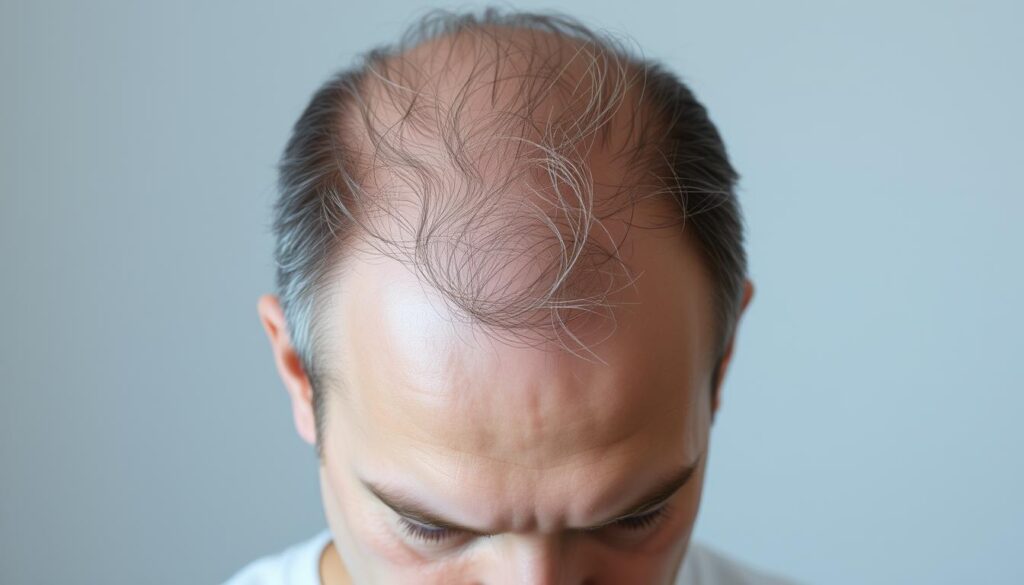
Not every case of thinning is the same—causes range from inherited hormones to stress and scalp disease.
Androgenetic alopecia, telogen effluvium, and traction
Androgenetic alopecia (male pattern baldness) is genetic and hormone-driven. It usually begins with a receding hairline and a growing crown spot and often progresses if untreated.
Telogen effluvium causes sudden, diffuse shedding after severe stress, illness, or medication. It is often reversible once the trigger passes.
Alopecia areata creates round patches from an autoimmune attack and can affect scalp, brows, or beard. Tight styles, like constant top knots or braids, cause traction alopecia by stressing follicles over time.
When to see a specialist for diagnosis
If you notice rapid loss, patchy spots, or scarring, seek a dermatologist. Tests such as a hair pull, dermoscopy, and targeted blood work pinpoint causes and rule out inflammatory scalp conditions like psoriasis or fungal infections.
“Correct diagnosis guides whether to manage, treat, or confidently move to a shaved look now.”
- Scarring alopecias permanently damage follicles and need early attention.
- Many men benefit from early intervention to slow progression and preserve density.
- The next section outlines treatments to consider alongside a short or shaved style.
| Cause | Key sign | Typical outcome |
|---|---|---|
| Androgenetic alopecia | Receding hairline, crown thinning | Progressive unless treated |
| Telogen effluvium | Diffuse shedding after stress/illness | Usually reversible |
| Alopecia areata | Round, smooth patches | Variable—may regrow or recur |
| Traction alopecia | Localized loss where styles pull | Often preventable; may be permanent if chronic |
Treatment paths to consider alongside a bald haircut
You can combine medical therapies and cosmetic fixes to manage thinning while keeping a neat, short head. Below are common options, how they work, and what to expect.
Finasteride, minoxidil, and low-level laser therapy
Finasteride lowers DHT and is a go-to for male pattern hair loss. It helps slow loss and can regrow hair for eligible men, but use requires medical supervision.
Minoxidil widens blood flow to follicles. Apply as directed—typically twice daily—and expect gradual growth over months with consistent use.
Low-level laser therapy (LLLT) uses red light to boost cellular energy in follicles. Devices exist for home use or clinic sessions and work best when used regularly.
PRP, dermarolling, and scalp micropigmentation
PRP involves a blood draw, centrifuge, and injections of growth-factor–rich plasma into thinning zones to stimulate growth. Results vary by patient.
Dermarolling creates microchannels that can improve topical absorption of minoxidil when done on a proper schedule.
Scalp micropigmentation (SMP) is a non-surgical cosmetic option that reduces contrast and pairs well with a short buzz for a fuller visual effect.
Hair transplants vs. embracing the shave
Transplants (FUE/FUT) relocate follicles from donor areas to the top head and are permanent if donor supply allows. Other treatments need ongoing use to maintain gains.
“Set realistic expectations: medical options support growth only while used; transplants offer permanence, and SMP changes appearance rather than density.”
- Combine approaches for flexibility: medical therapy plus SMP or periodic LLLT can preserve options over time.
- Consult a specialist to match treatments to goals, health profile, and lifestyle.
| Option | How it works | Notes |
|---|---|---|
| Finasteride | Reduces DHT | Prescription; monitor side effects |
| Minoxidil | Vasodilator for follicles | Topical; twice-daily use; results in months |
| LLLT | Stimulates cellular activity | Home or clinic; regular sessions required |
| PRP | Growth-factor injections | Clinic procedure; multiple sessions |
| SMP | Cosmetic pigment to reduce contrast | Non-surgical; long-lasting visual effect |
| Hair transplant | Relocates follicles | Permanent if donor supply sufficient |
Style mistakes to avoid as hair thins
Small styling mistakes can turn mild thinning into a glaring focal point in photos and daily life. Make choices that work with your current density and head shape, not against it.
Avoid stretching a side part into a see-through combover that collapses in wind or bright light. That move draws attention to the very area you want to downplay.
Skip sparse spikes when density is low; gaps between spikes highlight scalp shine and make thin spots obvious. Also, tight braids or locs add traction stress and can speed loss along the hairline and crown.
Practical corrections: trim the top as it thins to reduce contrast with the sides and back. Ask a barber to taper sides and clean the neckline so the silhouette stays sharp as density changes.
Switch heavy, glossy products for light, matte finishes. Work under even lighting and take periodic photos from multiple angles to judge whether your current hairstyle still works.
| Mistake | Why | Better way |
|---|---|---|
| See-through combover | Collapses in motion | Shorter top or buzz |
| Sparse spikes | Emphasizes gaps | Even short length |
| Tight braids/locs | Causes traction | Looser styles or short cuts |
Tip: take a gradual path—shorten the top, try a buzz, then move to a full shave when you feel ready. The best way to avoid mistakes is to respect current density and your head shape.
Building confidence with your bald haircut
A confident short top can reshape how others read your whole look. Many men find that shorter hair or a clean shave looks younger and more intentional than stretched, thinning styles.
Owning the look: wardrobe, grooming, and posture
Reframe the change as a style upgrade that simplifies grooming and sharpens your personal brand. A tidy routine makes mornings faster and image clearer.
Small wardrobe tweaks help. Choose well-fitted shirts, clean sneakers or boots, and frames that flatter head shape. These choices direct attention to face and posture, not the top.
Grooming matters: keep brows trimmed, maintain a neat beard or stubble, and use a light matte moisturizer on the scalp. That polish reads intentional in photos and meetings.
- Practice good posture and steady eye contact—confidence reads louder than hair.
- Use hats as planned accessories, not hiding tools; aim for sun protection and style.
- Update profile photos and keep a clipper/shaver schedule so you always feel dialed in.
| Area | Action | Why it helps |
|---|---|---|
| Wardrobe | Fit-focused shirts, clean shoes, glasses | Sharp silhouette shifts focus to face and neck |
| Grooming | Trim brows, maintain beard, moisturize scalp | Neat details project care and intent |
| Posture | Stand tall, square shoulders, eye contact | Signals confidence beyond appearance |
| Community | Barbers, groups, friends | Practical tips and reassurance during transition |
Real results: men at Norwood 6 often report looking cleaner and more stylish after choosing a buzz or shave. Confidence grows with repetition—each clean pass reinforces the decision and makes the look feel natural over years.
Conclusion
Settle on a clean, low-effort option that highlights your features and saves time. For crown thinning, a clean shave, short stubble, or a uniform buzz gives the most consistent, low-maintenance result. These approaches pair well with classic cuts like the crew and Caesar during earlier stages.
Avoid see-through combovers and the power donut; those styles date quickly and draw attention to loss. Balance a short top with facial hair—from stubble to a short boxed beard—to add structure and focus to the face.
Keep scalp care simple: exfoliate, cleanse, moisturize, and use SPF. Use anti-shine lotions, fibers, or spray-on color for transitions, and consider treatments such as finasteride, minoxidil, PRP, LLLT, dermarolling, SMP, or transplants if you want to preserve density.
Start with a buzz to preview the shape, then move to a clean shave if you like the look. Own your choice, keep the routine simple, and enjoy the freedom of a well-kept head.
